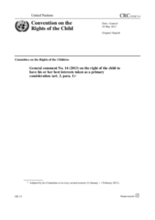General Comment 14 issued by the Committee on the Rights of the Child, refers to article 3(1), of the Convention on the Rights of the Child that asserts the right of the child to have his or her best interests taken as a primary consideration in all actions or decisions that concern him or her (in both the public and private spheres). The General Comment defines the requirements for due consideration of the child’s best interests, in judicial and administrative decisions as well as all other actions concerning the child, and provides a framework for assessing and determining the child’s best interests. This right is particularly relevant to decision about children’s care, as the Convention explicitly refers to the child’s best interests in article 9: separation from parents; article 10: family reunification; article 18:parental responsibilities; article 20: deprivation of family environment and alternative care; article 21: adoption, among others.
The Committee underlines that “assessing the child’s best interests is a unique activity that should be undertaken in each individual case, in the light of the specific circumstances of each child or group of children or children in general. These circumstances relate to the individual characteristics of the child or children concerned, such as, inter alia, age, sex, level of maturity, experience, belonging to a minority group, having a physical, sensory or intellectual disability, as well as the social and cultural context in which the child or children find themselves, such as the presence or absence of parents, whether the child lives with them, quality of the relationships between the child and his or her family or caregivers, the environment in relation to safety, the existence of quality alternative means available to the family, extended family or caregivers.”
The Committee provides also important guidance on the application of this right in the context of care decisions, including placement in alternative care. For example, “regarding religious and cultural identity, when considering a foster home or placement for a child, due regard shall be paid to the desirability of continuity in a child’s upbringing and to the child’s ethnic, religious, cultural and linguistic background (art. 20, para. 3), and the decision-maker must take into consideration this specific context when assessing and determining the child's best interests.” The Committee also highlights that in respect of adoption (art. 21), “the right of best interests is further strengthened; it is not simply to be “a primary consideration” but “the paramount consideration”. Indeed, the best interests of the child are to be the determining factor when taking a decision on adoption, but also on other issues.”

